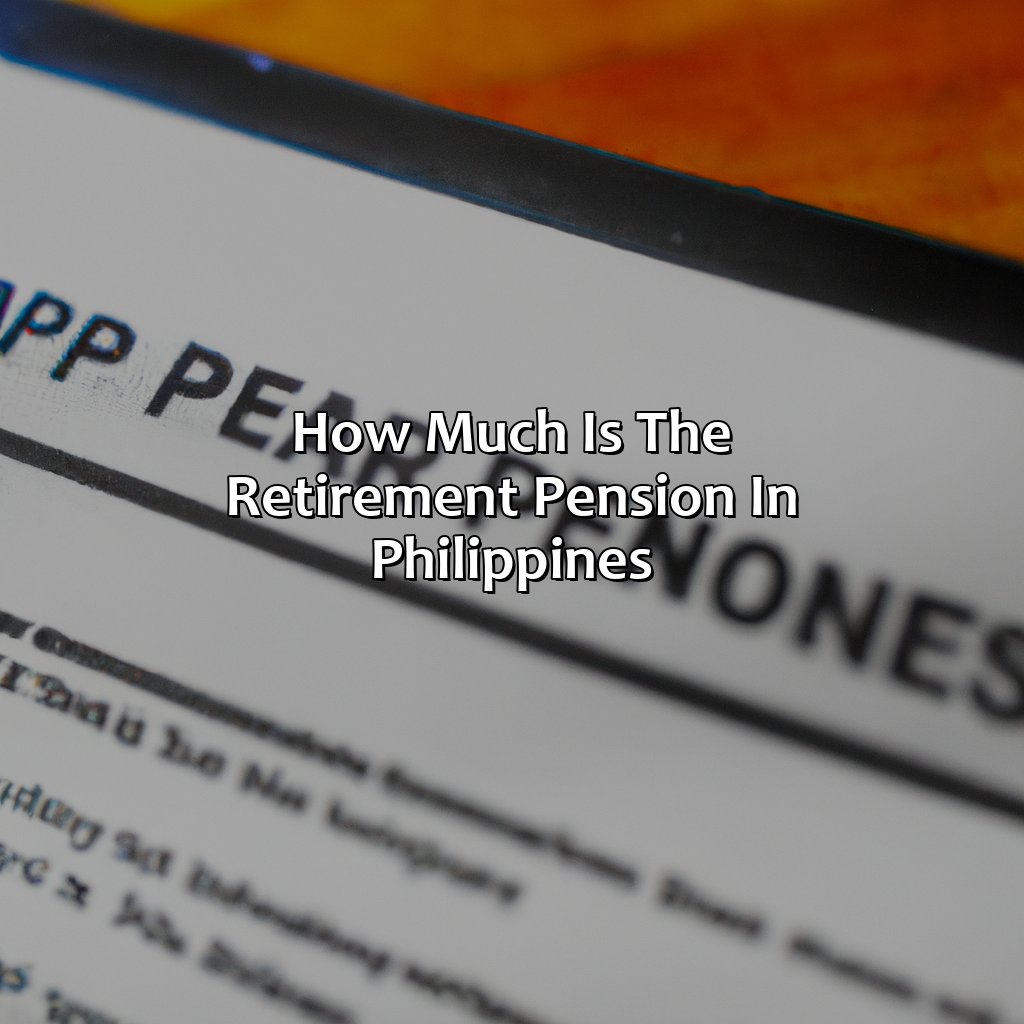How Much Is The Retirement Pension In Philippines?
Key takeaway:
- The retirement pension in the Philippines is divided into three categories: Social Security System (SSS) Pension, Government Service Insurance System (GSIS) Pension, and Private Retirement Plans.
- Eligibility and qualification for retirement pension in the Philippines depends on age requirement and months of contribution. Retirement benefits calculator is available to compute for the estimated pension.
- Retirement pension rates vary depending on the category of pension. As of 2021, SSS Pension rates range from PHP 3,000 to PHP 20,000, while GSIS Pension rates range from PHP 12,600 to PHP 97,200. Private retirement plan rates depend on the terms of the plan.
- In addition to the retirement pension, retirees in the Philippines are entitled to additional benefits such as Philhealth coverage, senior citizen discounts, and expanded senior citizen act benefits.
Are you confused about the retirement pension in Philippines? You need not worry anymore as this article provides a comprehensive guide to understanding the pension system in the country and how much pension you can expect.
Overview of Retirement Pension in the Philippines
The retirement pension scheme in the Philippines is designed to secure the future of retired citizens. The process of availing the pension plan starts once an individual reaches the retirement age. The government provides two pension plans: the Social Security System and the Government Service Insurance System. Both plans have specific eligibility criteria, and monthly pension payouts depend on the contribution made by the employee. In addition, retired citizens can also opt for private pension plans offered by banks or insurance companies. These plans have varying payout frequencies and may differ in terms of benefits.
Retired Filipinos can choose to receive their pension either through a bank or in person. Moreover, the amount of pension can be increased by contributing to the pension fund beyond the required years. Retired individuals who are currently employed can also increase their payout by increasing their monthly contribution before retirement. It is highly recommended that individuals seek professional advice to make the most of their pension plan.
Overall, retired citizens need to understand and plan for their pension schemes in advance to live a comfortable life post-retirement. Proper planning will help them secure their financial future and allow them to maintain their standard of living.
Categories of Retirement Pension in the Philippines
To grasp the distinctions between kinds of retirement pension in the Philippines, think “SSS Pension,” “GSIS Pension,” and “Private Retirement Plans.” We’ll outline their advantages and eligibility requirements. This section will present these categories and explain how they can be a solution for you.
Social Security System (SSS) Pension
Provident Fund for Retirement Pension in the Philippines
The Provident Fund for Retirement Pension in the Philippines, commonly known as the Social Security System (SSS) Pension, provides financial assistance to retired workers. Here are three essential points about it:
- Eligibility: The SSS pays a monthly pension to workers who have paid at least 120 monthly contributions before retiring. Workers must be at least 60 years old when applying or at least 65 if they did not meet the required contribution period.
- Amount of Pension: The monthly pension amount depends on the number of contributions and average monthly salary credit earned during employment. For instance, those who have 240 months of contribution can get a minimum amount of Php3,200/month up to as high as Php13,000/month.
- Payment Options: Retirees can receive their pension either through bank transfer or directly from SSS offices all over the country.
It is also good to note that pensioners can apply and get loans using their SSS membership status. Taking advantage of this opportunity is an easy and affordable way to cover any unexpected expenses that may arise in daily life. Retirement may mean the end of work, but with GSIS Pension in the Philippines, it’s the start of a new career as a professional Netflix binge-watcher.
Government Service Insurance System (GSIS) Pension
The retirement pension offered by the GSIS is a type of benefit scheme aimed to provide financial assistance to their retired members who rendered service as employees in the public sector. This pension plan caters specifically to workers of government agencies, state-run corporations, and offices within the Philippines. It includes early retirement options for those who have reached 10 years of service and normal retirement options for those who have completed 15 years of service. Pension amounts are based on average monthly compensation and years of service, with additional benefits such as disability compensation, survivorship benefits, and other health care assistance.
A distinguishing feature of GSIS pension is its survivorship benefit program that covers surviving spouses or beneficiaries in case of death. This means that adequate financial support is catered even after the retiree passes away. Widows are given up to 50% of the retiree’s basic pension which increases according to their own age.
Nowadays, GSIS pension offers online access through their website enabling members to manage their accounts more conveniently and efficiently. Through this platform, retirees can claim pensions online relieving them from the stress of long queues endured in its physical office location.
Saving for retirement is like playing hide and seek, but instead of finding the hidden treasure, you just hope the treasure finds you – especially with private plans in the Philippines.
Private Retirement Plans
Private pension schemes are personalized retirement plans that employees can set up with private providers. These schemes ensure regular income flow upon retirement and eventually easing the burden on social pension systems.
Different insurance providers offer various levels of retirement benefits, and prospective savers should consider their contribution sizes, investment types, benefits limitations, and the potential returns before choosing a private retirement plan. Private pensions remain critical due to their flexibility of options and covering gaps in social security nets.
Pro Tip: Before selecting a private pension scheme, aspiring retirees or employees must evaluate and weigh options to ensure they save enough for their desired retirement age.
Getting old has its perks, like qualifying for a retirement pension – just make sure you don’t spend it all on bingo and prune juice.
Eligibility and Qualification for Retirement Pension
To get a retirement pension in the Philippines, you must comprehend the age requirement and months of contribution. Let’s take a peek at the Age Requirement, Months of Contribution, and Retirement Benefits Calculator sub-sections. These will help you figure out if you are eligible.
Age Requirement
The retirement pension in the Philippines is available for individuals who have reached the appropriate age. The age requirement varies depending on the type of pension program, but typically ranges from 60 to 65 years old.
Upon reaching this age, seniors can apply to receive monthly benefits that can support their financial needs during retirement.
Additionally, certain factors may affect an individual’s eligibility and qualification for retirement pension programs. These include a person’s number of years employed, whether they contributed to the social security system, and other circumstances such as disability or death of a loved one.
To increase the amount received through monthly benefits, one can choose to delay their retirement until they reach a later age or contribute more towards their social security program during their working years. Taking advantage of tax incentives and diversifying investment portfolios can also help bolster retirement income.
Overall, it is important for individuals approaching retirement to research and plan accordingly in order to maximize their benefits and ensure financial stability during their golden years.
Looks like you’ll have to work for a few months longer if you want to fund your retirement plans in the Philippines. Time to dust off that work ethic!
Months of Contribution
The duration of contribution is a crucial factor in determining eligibility for retirement pension benefits. The number of months that an individual has contributed to the social security system or SSS will determine their qualification for a retirement pension.
According to the SSS, members who have made at least 120 monthly contributions are eligible for the retirement pension benefit. The amount of the monthly pension will depend on the total number of contributions and the average monthly salary credit divided by 12.
It’s worth noting that for those who have not reached 120 contributions but have reached at least ten years of paying contributions, they may still qualify for a lump sum amount. However, this lump sum can only be granted once and upon reaching the age of 65.
To ensure your eligibility and maximize your benefit claims, it is best to regularly update your SSS records and continue paying regular contributions until you reach the qualifying minimum months needed. Additionally, taking advantage of voluntary payment schemes could also help increase your potential benefits in the future.
Calculating your retirement benefits may take some number crunching, but at least you won’t have to worry about carrying the one when you retire to the Philippines.
Retirement Benefits Calculator
Retirement Benefits Estimator determines the entitlement of benefits and qualification for retirement pension. A comprehensive table showing contribution period, average monthly salary credit and corresponding estimated monthly pension is included.
The Retirement Benefits Calculator table comprises of the category such as Social Security System (SSS), Government Service Insurance System (GSIS) and Home Development Mutual Fund (Pag-IBIG) with their member type, membership duration, monthly contributions and estimated monthly pension based on a certain retirement age.
Apart from the government programs, private companies may have supplementary pensions provided for their employees which can be determined using a similar program.
Retirement pension in Philippines was last reviewed on May 19th 2021 by Department of Labor and Employment.
Retirement in the Philippines might not make you a millionaire, but at least you won’t be forced to eat cat food in your golden years.
How Much is the Retirement Pension in the Philippines?
Explore rates for the SSS, GSIS and Private Retirement Plans in the Philippines to learn how much pension you’ll receive. In this section, all details on rates and plans are available. Read on to determine which plan is right for you.
SSS Pension Rates
For those wondering about the SSS pension rates, let’s take a look below.
| Monthly Salary Credit (MSC) | Credited Years of Service (CYS) | Amount of Pension |
| P1,000 – P1,249.99 | 10 | P3,200 |
| P16,000 or more | 20 | P13,600 |
Keep in mind that these are only examples and the amount you may receive depends on a variety of factors unique to your situation. For more detailed information and calculations, you can visit the official SSS website.
Don’t forget to plan ahead for your retirement and ensure that you are contributing enough towards this fund so that you can enjoy financial stability during this phase of your life. Time is continuously moving forward and an opportunity missed today regarding early contributions towards building up your pension could be regretted later on in life. So start making wise decisions now onwards!
Looks like the only thing guaranteed in life is GSIS Pension Rates not keeping up with the rising cost of living in the Philippines.
GSIS Pension Rates
The pension scheme for retired government officials in the Philippines is an important aspect of their financial stability. The amount of pension can vary depending on multiple factors such as length of service and type of retirement plan opted for.
To provide a clear idea about GSIS (Government Service Insurance System) retirement pensions, we have created a table below with relevant columns including years of service, age at retirement and estimated monthly pension.
| Years of Service | Age at Retirement | Estimated Monthly Pension |
| 15-19 years | 60 years old or more | P16,000 to P18,700 |
| 20-24 years | No Age Requirement | P19,000 to P22,300 |
| Above 25 Years of Service/ Optional Retirement | -do- | P30,000 to P35,400 |
It’s important to note that these rates are subject to change based on various factors such as inflation rates and government policies. Moreover, retirees must ensure that they have completed all necessary documentation processes and met the eligibility criteria for receiving their pensions.
Pro Tip: Retirees should regularly check the GSIS website or consult with the nearest GSIS office to stay updated on any changes or modifications made to the pension scheme.
Not saving for retirement? Might as well start practicing your cardboard sign-making skills now.
Private Retirement Plan Rates
For those wondering about investment options for their retirement, here are the rates and specific details for different Private Retirement Plans.
Below is a table presenting the rates of various Private Retirement Plans provided by companies in the Philippines:
| Company | Plan Type | Minimum Contribution | Maximum Contribution | Interest Rates |
|---|---|---|---|---|
| AIG Philippines Insurance | Variable Unit-Linked Pension Plan | ₱10,000 | Subject to company’s rules and regulations | Attractive potential investment returns over long-term |
| Sun Life Financial Philippines | Personal Pension Plan | ₱1,000 per month | Subject to brackets with a max of $100,000 annually (non-tax exempt) | invested primarily in bonds but also varies according to individual investor preferences |
While some companies may offer higher interest rates on their pension plans than others, it is important to consider each plan’s potential risks against its rewards.
Pro Tip: Always consult with a financial advisor before making any investment decisions.
Retiring in the Philippines means not only receiving a pension, but also getting extra perks like discounted healthcare and unlimited mangoes, because what’s retirement without healthy goodies and sweet treats?
Additional Benefits for Retirees in the Philippines
Retirees in the Philippines can find many advantages! Discover Philhealth Coverage, Senior Citizen Discounts, and Expanded Senior Citizen Act Benefits. These perks will make life easier for retirees. They include financial help for medical bills, discounted services, and more access to amenities.

Image credits: retiregenz.com by David Jones
Philhealth Coverage
Retirees in the Philippines can avail themselves of medical coverage through a government insurance program called Philhealth. Starting with a minimum monthly contribution, they can access various health services at reduced rates or even for free.
Philhealth Coverage ensures that pensioners receive medical attention without dipping into their retirement savings. The package includes basic maternity, infectious disease treatment, and hospitalization for serious illnesses like cancer and kidney diseases.
It is worth noting that Philhealth also provides outpatient packages for those who require dialysis treatment or laboratory testing, amongst others. These additional benefits provide retirees with peace of mind knowing that their healthcare needs are covered.
Missing out on Philhealth Coverage means missing essential healthcare benefits and financial protection. Do not hesitate to sign up and start contributing to secure a healthy retirement lifestyle.
Who says getting old doesn’t come with perks? Senior citizen discounts in the Philippines may just be the silver lining in all those gray hairs.
Senior Citizen Discounts
As retirees in the Philippines age, they are eligible for special provisions and treatments known as Elder Citizen Privileges. These benefits are designed to provide older citizens with a greater sense of security and peace of mind. Some of the essential benefits that form a part of these regulations are as follows:
- Cash Discounts: Elder citizens are entitled to concessions on cash purchases made of essential items such as medicines and groceries.
- Transport Concessions: Public transport services offer discounted travel tickets on buses, trains, and boats.
- Tax Incentives: Tax exemptions and subsidies on specific property or income taxes for senior citizens
- Utility Bill Payment Discount: Senior citizens can obtain up to 5% discounts on their utility payments for electric, water or communications bills.
Additionally, when it comes to land travel, generous discounts on fares make travel easier and more accessible for the elderly populace.
Elder Citizen Privileges not only provide financial assistance to seniors but help in encouraging society to recognize the invaluable contribution that older generations have made. It is important to note these provisions exist in the Philippines due to historical reasons where senior citizens were often overlooked by their families after retirement. The government wanted seniors’ lives free from stress & troubles caused by financial hardship whilst respecting them with dignity & care through these laws.
Expanded Senior Citizen Act Benefits
The benefits under the existing law that cater to senior citizens have been rekindled and extended through various programs. These are benefits that support the welfare of retired citizens in the Philippines.
- Healthcare Services: Free vaccination, medical check-ups, and access to discounted medicine.
- Transportation Services: A 20% discount on fares regardless of transportation mode local travel.
- Tuition Fee Discount: Universally, students paying for college tuition fees can avail a 10% reduction with an allocated budget
- Pension Adjustment Assistance: Retirees whose pensions mysteriously fail will receive aid from the government.
Apart from these benefits, eligible senior citizens can also get an exemption from payment for necessary government transactions and elections.
Senior citizen welfare is a top priority in Philippine laws while they are encouraged to add to continuing developmental policies by sharing their accumulated wisdom after retirement.
As per Philippine laws pertaining to senior citizens current as of August 27, 2021, senior citizens receive specific tax privileges regarding their retirement salaries – excluding wages or allowances granted by the employer – that can go up to 90%.
Five Facts About Retirement Pension in Philippines:
The maximum retirement pension amount in Philippines is ₱35,295. (Source: SSS)
The minimum retirement pension amount in Philippines is ₱2,000. (Source: SSS)
To be eligible for the retirement pension in Philippines, a member must have made at least 120 monthly contributions to the Social Security System (SSS). (Source: SSS)
Retirement pension in Philippines is calculated based on the member’s number of contributions and the average monthly salary credit (AMSC). (Source: SSS)
Aside from retirement pension, SSS also provides benefits such as disability, sickness, and maternity benefits. (Source: SSS)
FAQs about How Much Is The Retirement Pension In Philippines?
How much is the retirement pension in Philippines?
The amount of retirement pension in the Philippines depends on the years of service you have rendered. The average monthly pension ranges from ₱1,200 to ₱2,400.
Is there a minimum age requirement to be eligible for retirement pension?
Yes, the minimum age requirement to be eligible for retirement pension in the Philippines is 60 years old for government employees and 65 years old for private sector employees.
Can a retiree still work and receive retirement pension in the Philippines?
Yes, a retiree can still work and receive retirement pension in the Philippines. However, if the retiree finds another employment with the government or the private sector, he or she must not be earning more than the prescribed amount of salary. Otherwise, the retiree may be subject to a reduction or suspension of his or her pension.
Can a retiree claim a lump sum payment instead of a monthly pension in the Philippines?
Yes, a retiree can claim a lump sum payment instead of a monthly pension in the Philippines. However, this option is only available for those who have contributed to the Social Security System (SSS) for less than 10 years.
Can a retiree receive both SSS pension and GSIS pension in the Philippines?
No, a retiree cannot receive both Social Security System (SSS) pension and Government Service Insurance System (GSIS) pension in the Philippines. An individual may only receive one pension from either SSS or GSIS, depending on his or her employment history.
What are the requirements to apply for retirement pension in the Philippines?
The requirements to apply for retirement pension in the Philippines include a valid ID, a Social Security System (SSS) number, and proof of retirement such as a certificate of separation from employment or a letter of retirement acceptance from the employer.
 Checkout this IRS Loophole
Checkout this IRS Loophole 





